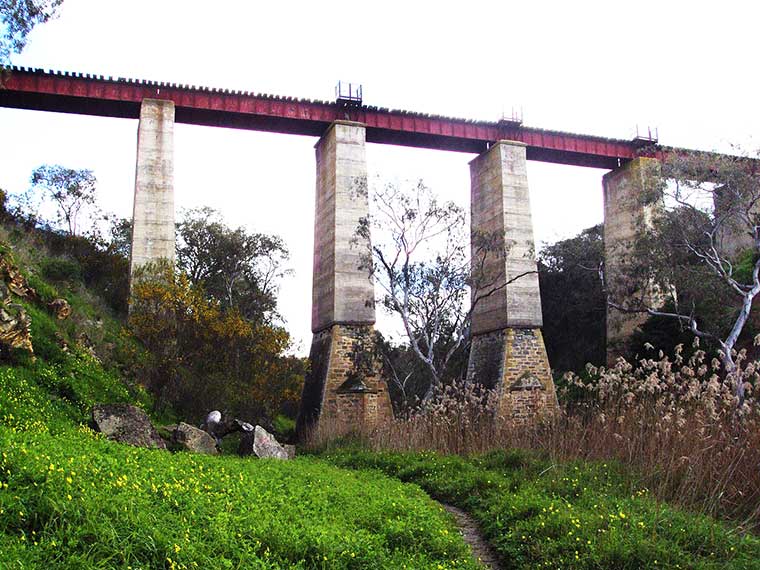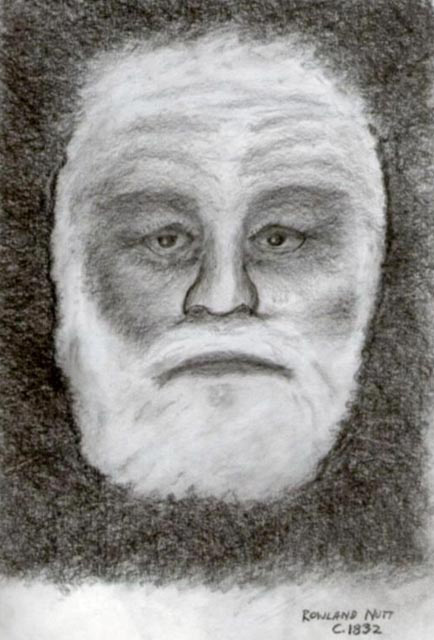Blackwood Estate/Park
Nutt's Blackwood Estate Sawmill - Rowland NUTT 1832 – 1914
from the South Australian Register (Adelaide, SA : 1839 - 1900) Thu 30 Jul 1868 Page 3
Thank you Nat Lemar for your research efforts.
COLONIAL INDUSTRIES - SAWMILLS OUT OF ADELAIDE
Mr. Nutt, having obtained Contract No.12 in May 1867 under the Government for the supply of 25,000 redgum sleepers for the Strathalbyn and Middleton Tramway, purchased a short time ago, one of Tennant & Co.’s steam-engines, provided with all the latest improvements.

Currency Creek Viaduct, built 1869, with Nutt's railway sleepers.
With a view to carrying out his contract, Mr. Nutt had the engine, with all its appurtenances, conveyed to the estate of Mr. Thomas Graham, J.P. of Blackwood Estate, formerly known as Dr. Rankine's Estate, where were standing in all their native luxuriance and majesty some of the finest old red gum-trees in the colony. These Mr. Nutt purchased from the proprietor for 10s per tree, and hence the erection of his steam sawmill at Blackwood Estate, which is situate about three and a half miles south of Macclesfield and four and a half north of Strathalbyn.
The first thing in connection with this mill, which stands at a distance of some 200 yards up a little gully near Blackwood Bridge, is a galvanized iron shed about 62 feet long by 22 wide. In the first compartment of this shed stands the horizontal engine, with its polished work and even movements. It is of 12 horse-power nominal, with a 12¼ -inch cylinder, having a 3-foot stroke, with reversing gear, and double expansive valves, which work in the steam-chest and on top of the cylinder.
There is an exhaust-pipe conducted below the cylinder into a cold-water tank, by which the content of the tank is brought up to and kept at very nearly boiling heat, and from this the boiler is supplied with hot water instead of cold.
The fly-wheel is 10 feet in diameter, and weighs close upon two tons. The main shaft is 4¾ inches in diameter, and the driving pulley of 5 feet diameter by 9 inches wide. This drives another pulley of 3 feet diameter, attached to the counter shaft.
On each side of this is fixed a pulley, worked on the same shaft; the one of 4 feet diameter, which moves a circular saw, the revolution of which is 600 to the minute. This saw is worked with great ease and without danger by a live and dead-pulley, so that the belt can be slipped on and off at will from one pulley to the other. It has been recently throwing off railway redgum sleepers, of 9 x 4½ inch, at the rate of 30 to the hour from the rough logs.
Then comes the vertical frame, which is also driven by a live and dead-pulley, together with the balance fly-wheel, which weighs 11½ cwt (hundredweight) and by a plate crank connected with the shaft by holes drilled for the purpose of shifting a pin to regulate the length of stroke.
With this frame the largest size log of our hardest colonial timber can be 'flitched' out in an hour. One log so flitched (cut to proper length) produced 40 sound sleepers. In a compartment which adjoins that containing the engine and its appendages is erected the boiler, which is one of the Cornish tubular make. It is 15¼ feet long by 5 feet in diameter, and has one of the most improved ''Steam Domes”' fixed on the top of it.
The timber is brought to the vertical frame, already referred to by a travelling frame, on pulleys and bracket, which is worked by an eccentric attached to the vertical frame shaft, the travelling frame proceeding from the south side of the mill to the circular table where the saw is brought to bear upon the logs, which, when cut into the required dimensions, are passed out at the opposite side from which they entered. Here they are received by the drays for conveyance to the tramway line.
In connection with this about 30 hands are employed. About 3,000 sleepers out of the contract number (25,000) had been supplied at the end of June, and from that time about 1,200 per week have been turned out of the mill.
We might add that one tree at Blackwood produced nine lengths of 9 feet each, and that 200 sleepers were produced from it.
On Tuesday the 15th of December 1868 a serious accident occurred at Mr Nutt & Tonkin’s Saw Mill, Blackwood Estate.
The engineer, Thomas Devereux, 37 years of age, from Adelaide, while engaged in turning off the water from the boiler was struck by the crank, which caused instant death. In regulating the water supply to the boiler he generally rested with his left hand on a projecting bolt, which brought his arm very close to the crank; this was quite evident, as the nut at the end of the bolt where he rested his hand was worn bright.
On an examination of the body it seems probable that the key which connects the rod with the crank must have first struck his arm and dragged him down. The crank in its next revolution seems to have struck his head, thereby drawing the whole of his body into the box where the crank worked. For about the space of three minutes his body was dragged to and fro in the box before the accident was discovered.
His head was completely severed, and the upper part of his body fearfully mangled. There were eight or nine hands at work at the time within two or three yards off where the accident happened, but being employed with their backs turned to where the engineer stood, they did not notice the accident until they discovered a decrease of speed in the engine.
Police constable Ryan was immediately on the spot, and informed Thomas Graham, Esq., J.P., of the circumstance; he came down and examined the body, and enquired into all the circumstances connected with the accident, and finding that the cause of death was so clear, he did not think it necessary to hold an inquest.
The remains of Mr. Devereux were interred at Strathalbyn on the following Wednesday. It was a fearful sight for man to see their fellow man in the short space of half-a-second taken away from amongst them.
In January 1869 Rowland employed additional sawyers from the mills at Mt Crawford to complete his contract. There were now 27 pairs of sawyers working at Blackwood Estate.
Rowland was the son of John NUTT and Mary Ann GRABHAM and was baptized on the 30th of July 1832 in Uppingham, Rutland, England. He was the youngest of eight children.

His mother died on the 29th of April 1840, aged 42 years in England. His father then married his wife’s sister, Hannah Hughes Ansell (widow) on the 25th of July 1840. Rowland was 17 years old when his father died in England on the 13th of February 1848 aged 62 years. Rowland departed London on board the “Casper” on the 2nd of June 1849, and arrived at Port Adelaide, SA on the 10th of September 1849.
Rowland went to the Victorian Goldfields and was one of the lucky ones. He was a carpenter and contractor by trade, and could read and write.
He married Mary Ann PLUMMER on the 22nd of December 1852 in the All Saints Church, Hindmarsh, SA. Mary was the daughter of Thomas PLUMMER and Elizabeth Jane JONES and was baptized on the 8th of March 1835 in Horsely, Gloucestershire, England. Mary had arrived in South Australia with her parents on the 27th of August 1840 on board the ship the "William Mitchell", from London.
At first Rowland and Mary lived at Brompton in a four roomed brick & stone home, with a cellar, garden and yard. It was on Port Road, opposite the Hindmarsh Post Office. They welcomed their first child; John Thomas, on the 7th of April 1854. In November 1855 they sold their home for cash and moved to Strathalbyn, where Rowland became a farmer and a contractor.
They purchased section 2740, Hundred of Bremer (New Hamburg), now Willyaroo, containing 73 acres and the property was located on the south east corner of the Langhorne Creek & Willyaroo Road.
In 1862 Rowland successfully tendered to make a flap and fix the Wellington Ferry for a cost of £44 19s. In 1865 he submitted his plan to build the New Hamburg Bridge (Willyaroo) and was successful, and the building of the Milang School. He also tendered to build the Clayton Jetty for £275 10s, but was unsuccessful.
Later in September he successfully tendered to build the Ferry at Thompson’s Crossing for a cattle punt at the cost of £673 10s. In 1867 he successfully tendered to build the North Parade Bridge and approach fence in Strathalbyn for £770 and the Meningie Jetty for £163.
Then in May he successfully tendered for labour and materials required in the construction of the roadway platform of the Currency Creek Viaduct. He also obtained Contract No.12 under the Government for the supply of 25,000 redgum sleepers for the Strathalbyn and Middleton Tramway.
On the 20th of February 1869, after the completion of the Strathalbyn Tramway Contract, Rowland auctioned the whole of his plant at the saw mill at Blackwood Estate.
On Tuesday the 23rd of February 1869 the Strathalbyn to Middleton Tramway was officially opened by the Governor, Sir James Fergusson.
After he completed the Strathalbyn Tramway in 1869 he successfully tendered to repair and add to the Milang Jetty for £870. In the same year he also successfully tendered to build a new bridge over the South Para River for £1,186. It had a 140 feet span, with girders weighing 60 tons and he completed it in June 1870.
The very same month he was committed for trial in Adelaide for concealing his estate being insolvent.
In September 1870 he successfully tendered to build the Second Valley Jetty for a cost of £1,385.
Unfortunately he did not sign the contract, because he went fraudulently broke, and was jailed, for nine months in the Yatala jail in 1871.
They had five more children born while they lived in New Hamburg; Rowland George, Mary Jane, Henry Lloyd, Florence Anne, and Alice Emily.
On release from jail, Rowland and his family moved to the newly proclaimed town of Yatina in 1874, and constructed a sixteen room, two-storey hotel for his family the same year. He also, with another man, built the Catholic Church in Yatina. Rowland believed that the new railway line from Peterborough to Hawker would make a stop at Yatina. The railway line was rerouted to stop at Black Rock and the Yatina Hotel stood in isolation.
Rowland also built stockyards at Yatina capable of holding 20,000 sheep, at which regular stock sales were held. In 1876 he purchased several blocks in the newly surveyed township of Orroroo and on the Wallaway plain and built a magnificent homestead for his family.
Rowland’s wife Mary, died in Orroroo on the 28th of September 1888, aged 53 years, and was buried in Yatina Cemetery.
Rowland then married Amy Adamson nee Farrow, a widow, on the 18th of June 1891, in the Holy Trinity Church in Adelaide. They had no children. Amy died on the 20th of January 1908, aged 72 years, and was buried with her first husband Robert Adamson in the Bordertown Cemetery.
Rowland died in Orroroo on the 28th of February 1914, aged 82 years, and was buried with his first wife Mary, in the Yatina Cemetery. Rowland had 33 grandchildren, (5 Deceased) and 16 great-grandchildren.



